LG LRSC26925SW, LSRC26923SW, LRSC26925TT, LSRC26923TT User Manual

24 HOURS A DAY, 7 DAYS A WEEK FOR LG CUSTOMER SERVICE Servicio LG(Atenci—n al Cliente) 24 horas al d’a, 7 d’as a la semana
LRSC26925SW
LRSC26923SW
LRSC26925TT
LRSC26923TT
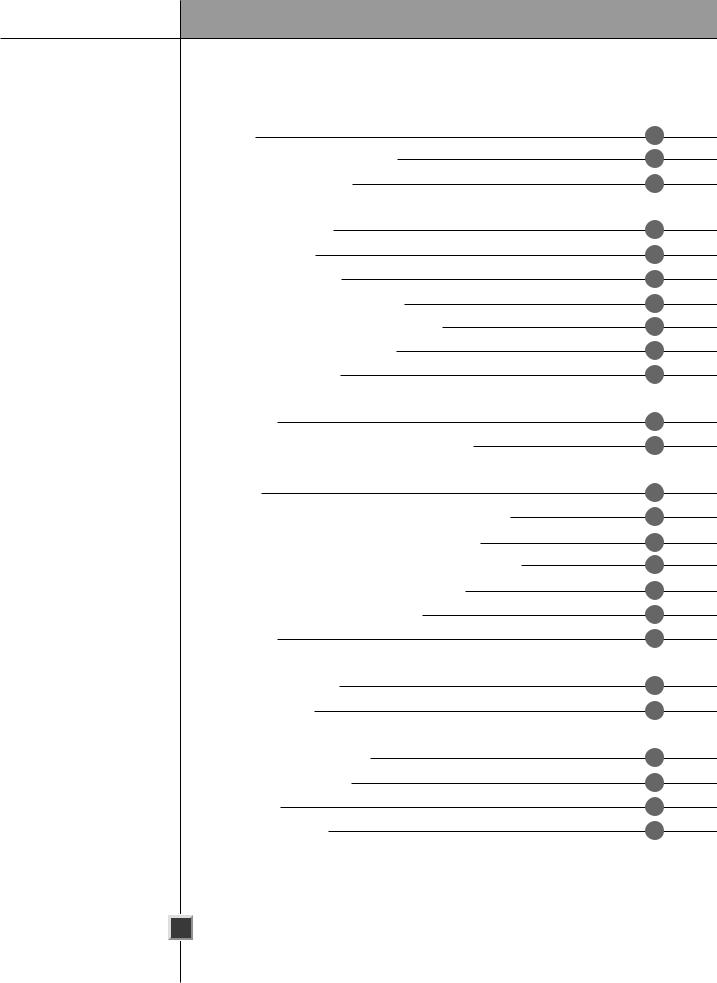
Introduction
Installation
Operation
Suggestion on Food Storage
Care and
Maintenance
Table of Contents
Entry |
3 |
Important Safety Instruction |
3 |
Identification of Parts |
6 |
Where to Locate |
7 |
Door Removal |
8 |
Door Replacement |
9 |
Water Pipe Installation |
9 |
Water Connection Instruction Guide |
10 |
Operation Instruction Guide |
12 |
Height Adjustment |
14 |
Starting |
15 |
Adjusting the Temperatures and functions |
15 |
(Dispenser/Automatic Icemaker) |
|
Shelf |
21 |
Wine Holder (Applicable to some models only) |
21 |
Egg Bin (Applicable to some models only) |
22 |
Humidity Control in the Vegetable Compartment |
22 |
Optichill Temperature Transition Corner |
23 |
Temperature Change at Optichill |
23 |
Optichill |
23 |
Location of Foods |
24 |
Storing Foods |
25 |
How to Dismantle Parts |
26 |
General Information |
28 |
Cleaning |
28 |
Troubleshooting |
29 |
2

Introduction |
|
|
|
|
|
|
|
|
Entry |
||
|
The model and serial numbers are found on the inner case or back of refrigerator |
||
|
compartment of this unit. These numbers are unique to this unit and not |
||
|
available to others. You should record requested information here and retain |
||
|
this guide as a permanent record of your purchase. Staple your receipt here. |
||
|
Date of purchase : |
|
|
|
|
||
|
Dealer: |
|
|
|
|
||
|
Dealer address: |
|
|
|
Dealer phone no.: |
|
|
|
|
||
|
Model no.: |
|
|
|
|
||
Important safety |
Serial no.: |
|
|
|
|||
SAFETY MESSAGES |
|||
Instructions |
This guide contains many important safety messages. Always read and obey |
||
|
|||
DANGER You will be killed or seriously injured if you don’t follow instructions.
WARNING You canbe killed or seriously injured if you don’t follow instructions.
CAUTION Indicates an imminently hazardous situation which, if not avoided, may result in minor or moderate injury, or product damage only.
All safety messages will identify the hazard, tell you how to reduce the chance of injury and tell you what can happed if the instructions are not followed.
 WARNING To reduce the risk of fire, electric shock or injury to persons when using your product, basic safety precautions should be followed, including the following. Read all instructions before using this appliance:
WARNING To reduce the risk of fire, electric shock or injury to persons when using your product, basic safety precautions should be followed, including the following. Read all instructions before using this appliance:
NEVER unplug your refrigerator by pulling on the power cord. Always grip the plug firmly and pull it straight out from the outlet.
Repair or replace inmediately all electric service cords that have become frayed or otherwise damaged. Do not use a cord that shows cracks or abrasion damage along its length or at either the plug or connector end.
When moving your refrigerator away from the wall, be careful not to roll over or damage it in any way.
Do not crush or damage the water line.
Do not store or use gasoline or other flammable vapors and liquids in the vicinity of this or any other appliance.
Do not allow children to climb, stand, or hang on the refrigerator doors or or shelves in refrigerator. They could damage the refrigerator and seriously injure themshelves.
Keep fingers out of “pinch point” areas; clearances between the doors and cabinet are necessarily small. Be careful when you open the doors when children are in he area.
Unplug your refrigerator before cleaning or making any repairs.
3NOTE: We strongly recommend that any servicing be performed by a qualified individual.
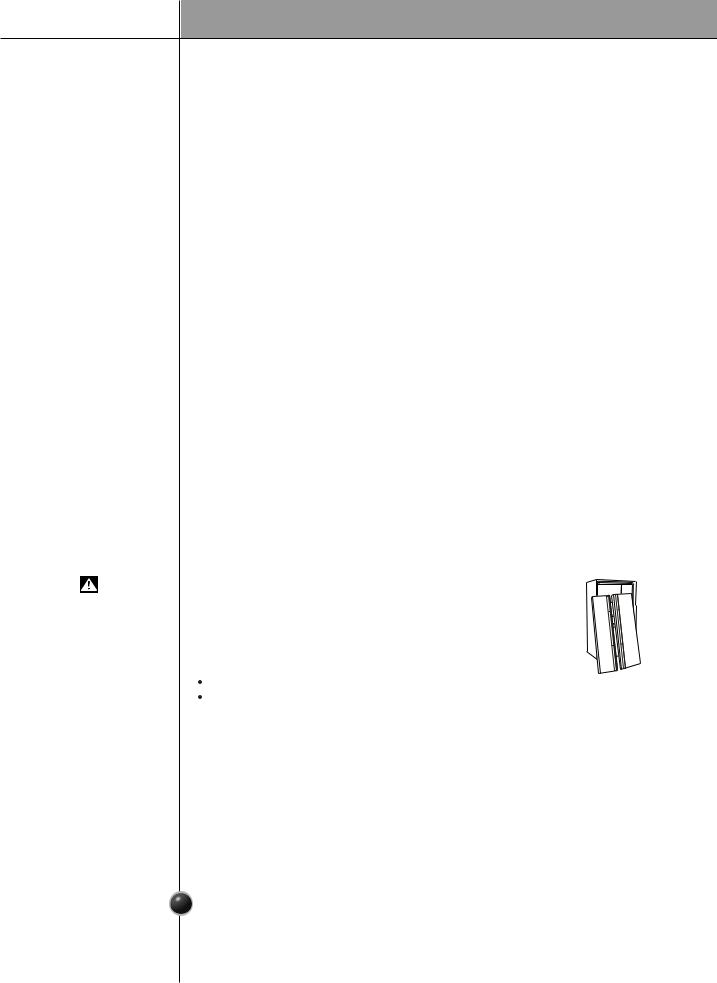
Introduction
 Before replacing a burned-out light bulb, unplug the refrigerator or turn off power at the circuit breaker or fuse box in order to avoid contact with a live wire filament. (A burned-out light bulb may break when being replaced). NOTE: Setting either or both controls to the OFF position does not remove power to the light circuit.
Before replacing a burned-out light bulb, unplug the refrigerator or turn off power at the circuit breaker or fuse box in order to avoid contact with a live wire filament. (A burned-out light bulb may break when being replaced). NOTE: Setting either or both controls to the OFF position does not remove power to the light circuit.
 Do not store bottles in the freezer compartment they may break when frozen, causing damage.
Do not store bottles in the freezer compartment they may break when frozen, causing damage.
 The refrigerator-freezer should be so positioned that the supply plug is accessible for quick disconnection when accident happens.
The refrigerator-freezer should be so positioned that the supply plug is accessible for quick disconnection when accident happens.
 For personal safety, this appliance must be properly grounded. Have the wall outlet and the circuit checked by a qualified electrician to make sure the outlet is properly grounded.
For personal safety, this appliance must be properly grounded. Have the wall outlet and the circuit checked by a qualified electrician to make sure the outlet is properly grounded.
 This refrigerator must be properly installed in accordance with the Attention
This refrigerator must be properly installed in accordance with the Attention
Installer Instructions that were taped to the front of the refrigerator.
 After your refrigerator is in operation, do not touch the cold surfaces in the freezer compartment when hands are damp or wet. Skin may adhere to the extremely cold surfaces.
After your refrigerator is in operation, do not touch the cold surfaces in the freezer compartment when hands are damp or wet. Skin may adhere to the extremely cold surfaces.
 In refrigerators with automatic icemakers, avoid contact with the moving parts of the ejector mechanism, or with the heating element that releases the cubes. DO NOT place fingers or hands on the automatic icemaking mechanism while the refrigerator is plugged in.
In refrigerators with automatic icemakers, avoid contact with the moving parts of the ejector mechanism, or with the heating element that releases the cubes. DO NOT place fingers or hands on the automatic icemaking mechanism while the refrigerator is plugged in.
 DO NOT refreeze frozen foods which have thawed completely. The United States Department of Agriculture in Home and Garden Bulletin No. 69 says:
DO NOT refreeze frozen foods which have thawed completely. The United States Department of Agriculture in Home and Garden Bulletin No. 69 says:
“...You may safely refreeze frozen foods that have thawed if they still contain ice crystals or if they are still cold below 40° (4°C).”
“...Thawed ground meats, poultry, or fish that have any off-odor or off-color should not be frozen and should not be eaten. Thawed ice cream should be discarded. If the odor or color of any food is poor or questionable, get rid of it. The food may be dangerous to eat.”
“Even partial thawing and refreezing reduces the eating quality of foods, particularly fruits, vegetables and prepared foods.
The eating quality of red meats is affected less than that of many other foods. Use refrozen foods as soon as possible to save as much of their quality as you can.”
DANGER |
Child entrapment and suffocation are not problems of |
||
|
the past. Junked or abandoned refrigerators are still |
||
Risk of child |
dangerous... even if they will sit for “just a few days”. |
|
|
|
|
||
|
|
||
entrapment |
BEFORE YOU THROW AWAY YOUR OLD REFRIGERATOR OR FREEZER |
||
|
|||
|
Take off the doors. |
||
|
Leave the shelves in place so that |
||
|
children may not easily climb inside. |
||
CFC DISPOSAL |
Your old refrigerator may have a cooling system that used CFCs |
||
|
(chlorofuorocarbons). CFCs are believed to harm stratospheric ozone. |
||
|
If you are throwing away your old refrigerator, make sure the CFC refrigerant is |
||
|
removed for proper disposal by a qualified servicer. If you intentionally release |
||
|
this CFC refrigerant, you can be subject to fines and imprisonment under |
||
|
provisions of environmental legislation. |
||
|
This appliance contains fluid (refrigerant, lubricant), is made of parts and |
||
|
materials which are reusable and / or recyclable. All the important materials |
||
|
should be sent to the collecton center of waste material and can be reused |
||
|
after rework (recycling). For take back, please contact with the local agency. |
||
|
4 |
|
|
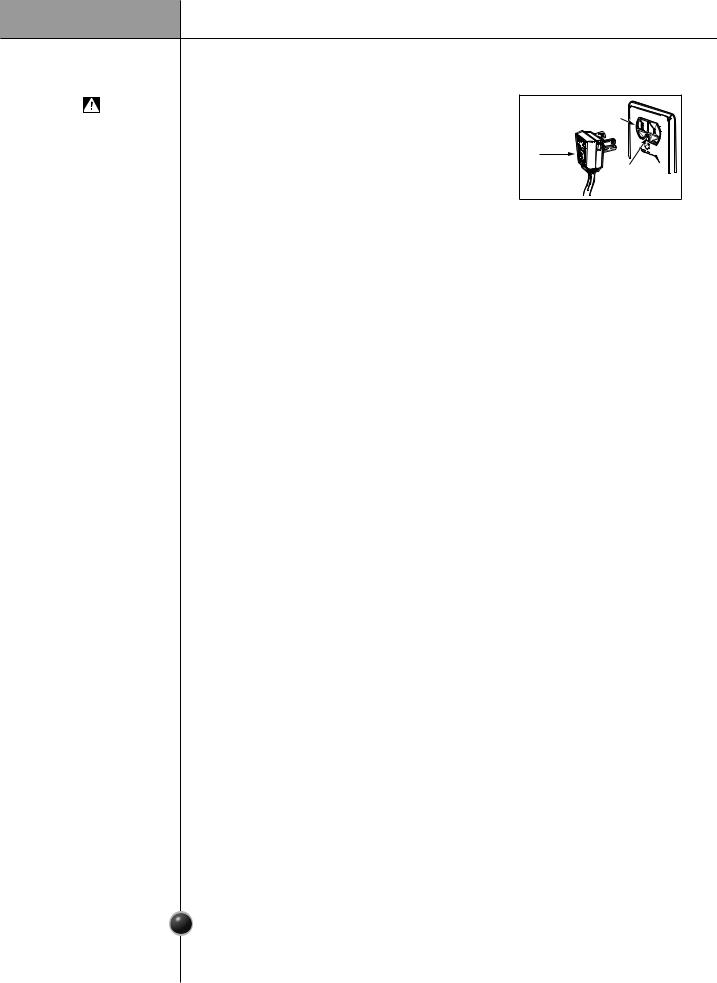
Introduction |
|
|
GROUNDING IMPORTANT: Please read carefully |
|
|
REQUIREMENTS |
TO CONNECT ELECTRICITY |
|
WARNING |
FOR PERSONAL SAFETY, this appliance must be |
3-prong |
grounding type |
||
Electrical |
properly grounded. Have the wall outlet and the |
wall receptacle |
|
||
Shock Hazard |
circuit checked by a qualified electrician to make sure |
3-prong |
the outlet is properly grounded. |
grounding |
|
|
plug |
|
|
|
Ensure proper |
|
|
ground exists |
|
|
before use. |
RECOMMENDED GROUNDING METHOD
The refrigerator should always be plugged into its own individual properly grounded electrical outlet rated for 115 Volts, 60 Hz, AC only and fused at 15 or 20 amperes. This provides the best performance and also prevents overloading house wiring circuits which could cause a fire hazard from overheated wires. It is recommended that a separate circuit serving only this appliance be provided.
Use a receptacle which cannot be turned off with a switch or pull chain. Do not use an extension cord.
Where a standard two-prong wall outlet is encountered, it is your personal responsibility and obligation to have it replaced with a properly grounded threeprong wall outlet.
Do not, under any circumstances, cut or remove the third (ground) prong from the power cord.
NOTE: Before performing any type of installation, cleaning, or removing a light bulb, turn the control (Thermostat, Refrigerator Control or Freezer Control, depending on the model) to OFF and then disconnect the refrigerator from the electrical source. When you are finished, reconnect the refrigerator to the electrical source and reset the control (Thermostat, Refrigerator Control or Freezer Control, depending on the model) to the desired setting.
USE OF EXTENSION CORDS
Because of potential safety hazards under certain conditions, we strongly recommend against the use of an extension cord. However, if you still elect to use an extension cord, it is absolutely necessary that it be a UL-listed (in the United States), 3-wire grounding type appliance extension cord having a groundind type plug and outlet, and that the electrical rating of the cord be 15 amperes (minimum) and 120 volts.
Use of an extension cord will increase the clearance needed for the back of the refrigerator.
If the supply cord is damaged, it must be replaced by the manufacturer or its service agent or a similarly qualified person in order to avoid any hazard.
5
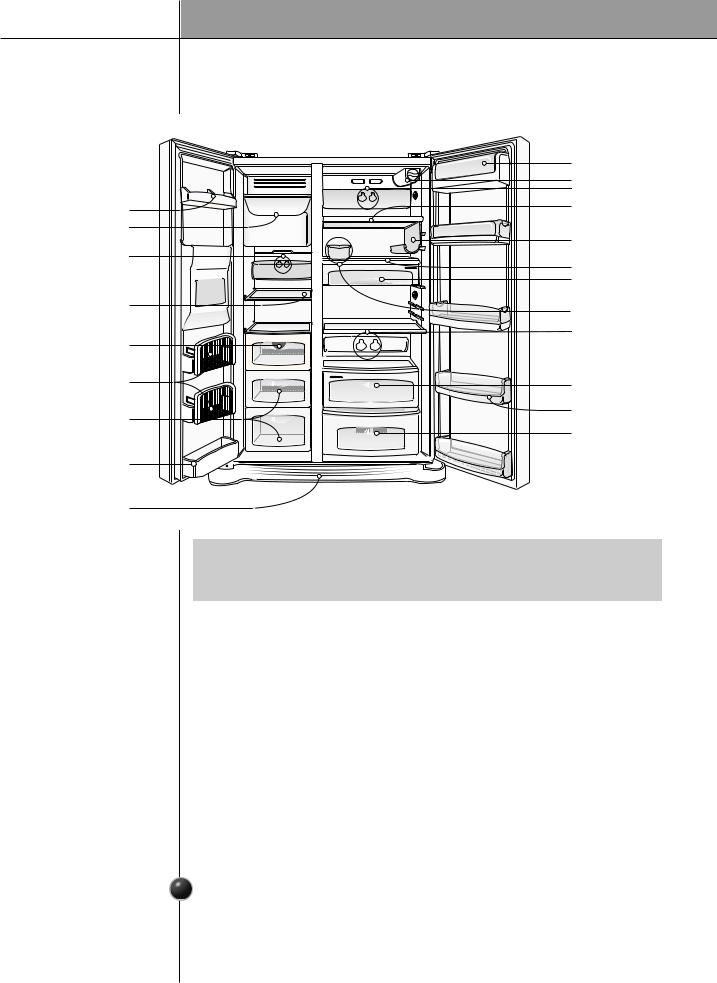
Introduction
Identification of Parts
Freezer |
Refrigerator |
|
Compartment |
Compartment |
|
|
Dairy Corner |
|
|
Water Filter |
|
|
Lamp |
|
Door Rack |
Shelf |
|
|
||
Automatic |
|
|
Icemaker |
Wine holder |
|
|
||
Lamp |
Shelf |
|
|
||
|
Snack Drawer |
|
Shelf |
Egg Box |
|
(steel or glass) |
||
|
||
|
Lamp |
|
Jet Freezing |
|
|
Door Rack |
Vegetable Drawer |
|
|
||
Drawer |
Door Rack |
|
|
||
|
Optichill |
|
Door Rack |
|
Lower Cover
NOTE
•If you find some parts missing from your unit, they may be parts only used in other models. (i.c. the Optichill is not included in all models)
6
6

Introduction
|
Where to Locate |
|
Select a Good |
1. Place your appliance where it is easy to use. |
|
Location |
2. |
Avoid placing the unit near heat sources, direct sunlight, or moisture. |
|
||
|
3. |
To avoid vibrations, the appliance must be leveled. |
|
4. |
Do not install this refrigerator in areas where the ambient temperature is below 41° F. |
|
|
It will have an adverse effect on performance. |
|
5. |
Allow the clearance of at least 2 inch from the ceiling and 1 inch from the side walls |
|
|
for better cooling efficiency, ease of installation, proper air circulation and electrical |
|
|
connections. |
Method to remove protection film (Some Model)
1.Grasp the handles with both hands and hold them upward to remove.
2.Entirely remove the protection film adhered to the external surface of the door.
3.Assemble the fixing bracket on the both ends of the handle to the fixing bolt of the door and lower the handle downward until it is entirely fixed.
7

Installation
|
Door removal |
|
Warning |
Electric Shock Hazard |
|
|
Disconnect electrical supply to refrigerator before installing. |
|
|
Failure to do so could result in death or serious injury. |
|
|
If your entrance door is too narrow for the |
|
|
refrigerator to pass through, remove the |
Lower Cover |
|
refrigerator door and pass the refrigerator laterally. |
|
Remove Lower |
Remove the lower cover by lifting upward, and |
|
Cover and |
then pull up the water feed tube while pressing |
|
Water Feed Tube |
area shown in the figure to the right. |
Water Feed Tube |
NOTE
•If a tube end is deformed or abraded, trim the part away.
Disconnecting the tube under the door causes about 1.5 litters water to flow out. Please put up a big container to prevent it.
|
|
Hinge |
Connection |
Remove the |
1) Remove the hinge cover by loosening the |
Cover |
|
|
Wires |
||
Freezer |
screws. Disconnect all connections except |
|
|
Compartment |
the ground line. |
|
|
Door |
Upper Hinge |
|
Earth Line |
|
2) Remove the keeper by rotating it counter |
Keeper |
Upper Hinge |
|
|
||
|
|
|
|
|
clockwise and then lifting the upper |
|
|
|
hinge up . |
|
|
NOTE
• When removing the upper hinge, be careful that the door does not fall forward .
3) Remove the freezer compartment door by
lifting it upward. This time, the door should be lifted enough for the water feed tube to
be completely pulled out.
Lower hinge
NOTE
•After removing the door, take it into the kitchen where you are installing the refrigerator. Lay it down on a blanket and be careful to avoid damaging the water feed tube.
Remove the |
1) Loosen the hinge cover screws and remove |
|
|
Refrigerator |
the cover. Remove connection wire, if any, |
|
|
Door |
except for the ground line. |
Connection |
|
|
|
|
|
|
|
Wires |
|
|
2) Remove keeper by rotating it clockwise |
Upper Hinge |
Keeper |
|
|
||
|
|
|
|
|
and then remove the upper hinge by lifting |
|
|
|
it up . |
|
|
3) Remove the refrigerator compartment door by lifting it up.
8 |
Lower Hinge |
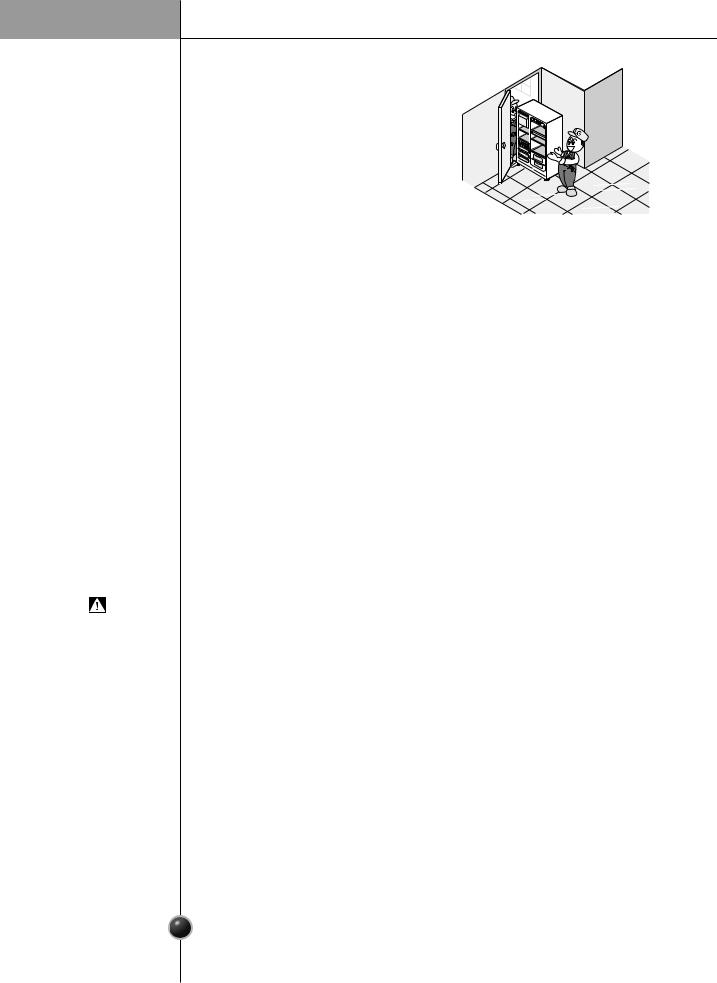
Installation
Move the Push the refrigerator sideways through the
Refrigerator entrance door as shown in the right picture.
Door replacement
Mount the doors in the reverse order of removal after the refrigerator is brought to the installation area.
Feed water tube installation
Before Automatic icemaker operation needs water pressure of 21.3~121psi(lb/inch2) (That Installation is, a 7oz. paper cup will be filled within 3 sec.).
If water pressure does not reach the rated 21.3psi(lb/inch2) or below, it is necessary to purchase a separate pressure pump for normal automatic icemaking and cool water feed.
Keep the total length of the water feed tube within 40 feet and be careful not to bend or kink the tube. If the tube is longer than 40 feet, the icemaker and water dispenser will not operate properly.
Install the water feed tube at a place free from heat.
Warning |
Connect to potable water supply only. |
Refer to instructions with water filter kit for installation.
9

Installation
|
Water Connection Instruction Guide |
Connecting |
Read all directions carefully before you begin. |
the Refrigerator |
|
to a Water Source |
|
Warning |
Connect to potable water supply only. |
|
|
|
IMPORTANT |
|
• If operating the refrigerator before installing the water connection, turn icemaker |
|
to the OFF position to prevent operation without water. |
|
• All installations must be in accordance with local plumbing code requirements. |
|
• Use copper tubing and check for leaks. |
|
• Install copper tubing only in areas where temperatures will remain above freezing. |
|
• It may take up to 24 hours for your icemaker to begin producing ice. |
Tools Required |
|
Standard screwdriver |
|
|
7/16-inch and 1/2-inch open-end wrenches or two adjustable wrenches |
|
1/4-inch nut driver |
|
1/4-inch drill bit |
|
Hand drill or electric drill (properly grounded) |
NOTE
•Your refrigerator dealer has a kit available with a 1/4-inch saddle-type shut-off valve, a union, and copper tubing. Before purchasing, make sure a saddle-type valve complies with your local plumbing codes. Do not use a piercing-type or 3/16-inch saddle valve which reduces water flow and clogs more easily.
1010
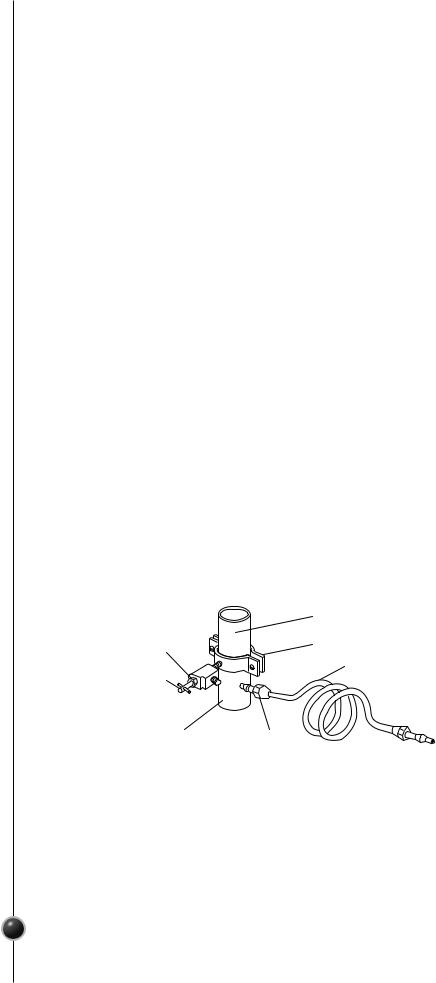
Installation |
|
|
|
|
|
|
|
|
|
|
|
|
|
Connect |
|
1. Unplug refrigerator or disconnect power. |
|
|
||
the Tubing to |
|
2. Turn OFF main water supply. Turn on the nearest faucet to relieve the pressure |
||||
Water Line |
|
|||||
|
on the line. It may help to open an outside faucet to allow the water to drain from |
|||||
|
|
|||||
|
|
the line in the house. |
|
|
||
|
|
3. Find a 1/2-inch to 1-1/4-inch vertical COLD water pipe near the refrigerator. |
||||
|
|
|
|
|
|
|
|
|
NOTE |
|
|
||
|
|
• Horizontal pipe will work, but the following precaution must be taken: Drill on the top of |
|
|||
|
|
the pipe, not the bottom. This will help keep water away from the drill. This also keeps |
|
|||
|
|
normal sediment from collecting in the valve. |
|
|
||
|
|
|
|
|
|
|
|
|
4. To determine the length of copper tubing you will need, measure from the |
||||
|
|
connection on the lower left rear of the refrigerator to the water pipe. Add 7 |
||||
|
|
feet (2.1m) to allow for moving refrigerator for cleaning. Use 1/4-inch O.D. |
||||
|
|
(outside diameter) copper tubing. Be sure both ends of copper tubing are cut |
||||
|
|
square. |
|
|
||
|
|
5. Using a drill, drill a 1/4-inch hole in the cold water pipe you have selected. |
||||
|
|
6. Fasten shut-off valve to cold water pipe with pipe clamp. Be sure outlet end is |
||||
|
|
solidly in the 1/4-inch drilled hole in the water pipe and that the washer is |
||||
|
|
under the pipe clamp. Tighten packing nut. Tighten the pipe clamp screws |
||||
|
|
carefully and evenly so washer makes a watertight seal. Do not overtighten or |
||||
|
|
you may crush the copper tubing, especially if soft (coiled) copper tubing is |
||||
|
|
used. Now you are ready to connect the copper tubing. |
||||
|
|
7. Slip compression sleeve and compression nut on copper tubing as shown. |
||||
|
|
Insert end of tubing into outlet end squarely as far as it will go. Screw |
||||
|
|
compression nut onto outlet end with adjustable wrench. Do not over tighten. |
||||
|
|
8. Place the free end of the tubing into a container or sink, and turn ON main |
||||
|
|
water supply and flush out tubing until water is clear. Turn OFF shutoff valve |
||||
|
|
on the water pipe. Coil the copper tubing as shown below. |
||||
|
|
|
|
|
Cold Water Pipe |
|
|
|
Packing Nut |
Pipe Clamp |
|||
|
|
|
|
|||
|
|
|
|
|
Coil of Polyethylene or |
|
|
|
Shut Off Valve |
|
|
|
|
|
|
|
|
|
||
|
|
Compression Sleeve Compression |
|
|
||
111
